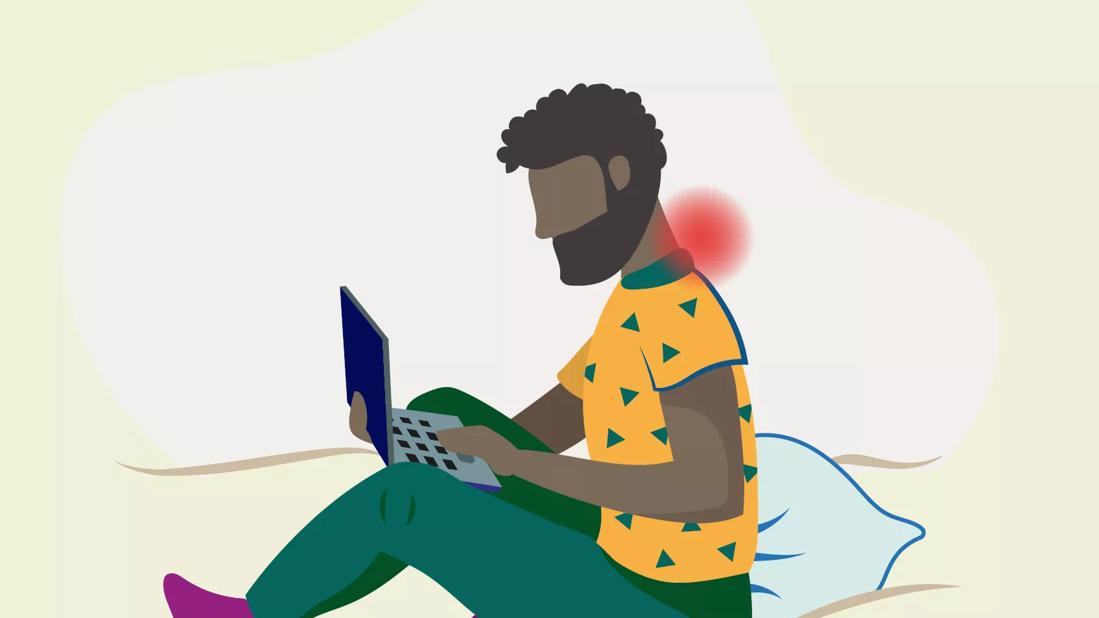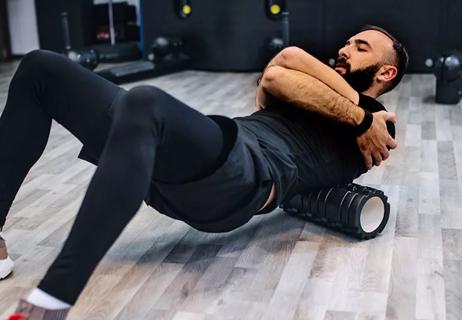Here’s why it may be happening and how you can find some relief

From working a sedentary desk job to looking down at your phone all the time to feeling the impact of aging, neck pain is unsurprisingly common. But that doesn’t mean you have to live with it.
Advertisement
Cleveland Clinic is a non-profit academic medical center. Advertising on our site helps support our mission. We do not endorse non-Cleveland Clinic products or services. Policy
Osteopathic medical specialist Fredrick P. Wilson, DO, talks about how to identify, alleviate and, in some cases, maybe even prevent your pain.
Studies show that as much as 86.8% of people experience neck pain at some point in their lives — which means that if you’re feeling sore, you’re certainly not alone. Dr. Wilson breaks down some of the most common causes for this type of pain.
“As we get older, our upper back muscles start to weaken, which can lead to a kind of forward bending,” Dr. Wilson says. “Every time we bend our head forward, we’re taking it out of balance.”
Your head, which weighs about 10lbs. to 12lbs., is typically balanced on top of your spine. But with every few degrees that you lean forward, it’s like your head becomes heavier and heavier, requiring your upper back and neck muscles to do more work than they’re supposed to do.
This can lead to strain, pain and minor imbalances, as well as cause other symptoms, like headaches.
“There are disks between each vertebra in the neck, which act as cushions and take some of the weight off of the joints,” Dr. Wilson explains. “But as we get older, we lose some of the water in the jelly of the disks, which makes the disks smaller.”
Advertisement
Over time, as weight is put on these joints, they react by developing arthritis. “Our neck joints are forced to do more work with more weight than they were when we were younger,” Dr. Wilson says.
And vibration can accelerate arthritis of the neck. If you’re a trucker, a bus driver or have another job where you experience a lot of vibration in your daily work, you’re more likely to develop this kind of pain.
The little bones that make up your spine are called the vertebrae. Between them are little cushions called disks. They serve as a buffer between your bones — but they can start degenerating over time. Though it’s a normal part of aging, it can be a painful one.
When one of these disks tears or leaks, it’s called a herniated disk, also known as a slipped, ruptured or bulging disk. “People often start to have discogenic pain and herniated disks after age 40,” Dr. Wilson says, “And after age 55, we start to see people who have cervical spondylosis.” This is a combination of conditions, including joint arthritis, disc degeneration and spinal stenosis, which can also cause pain to radiate down your arms.
If you work on a laptop, you’re primed for some neck issues. “Because these computers are small, people end up leaning forward more to look at their screens,” Dr. Wilson says. “This takes the head out of balance and can lead to neck and upper back strain.”
“Tech neck,” as it’s called, can also come from frequently looking down at your smartphone. That’s because dropping your head forward so often can impact change the curvature of your neck, straining muscles and causing wear and tear.
The admittedly robotic-sounding term “mechanical pain” refers to any back or neck pain that’s due to a structural imbalance (including bad posture, tech neck and more). “It usually involves a joint that’s not sitting quite right on another one,” Dr. Wilson explains.
If you work in specific job industries, you’re more likely to experience specific kinds of mechanical pain. For example, if you fix telephone wires for a living, you spend much of the day with your head tilted upward and turned back behind you.
“If your head is frequently held in positions that aren’t normal for the body, that puts a lot of strain on your muscles,” Dr. Wilson says.
If you’ve ever heard someone say, “I carry all my stress in my shoulders,” there’s some truth to it.
“Patients who have anxiety disorders or obsessive-compulsive disorder tend to hold their shoulders up a lot, which can cause chronic neck pain,” Dr. Wilson says. “The muscles there get really, really tight.” This is especially common in people who already have chronic illnesses like fibromyalgia.
Advertisement
Neck pain might be common, but that doesn’t mean you have to resign yourself to it.
“As we get older, we start losing our strength in our thoracic extensors, we tend to start leaning the head forward, which strains the upper back and neck,” Dr. Wilson reiterates. “If you can strengthen those muscles and pull your shoulders back, you’ll have less of a forward drop of the head, which will reduce your pain.”
These simple but effective moves can strengthen your neck and upper back muscles, allowing them to better support your head and, ultimately, relieve some of your pain.
Advertisement
Dr. Wilson walks you through some of the other things you can do to alleviate your current neck and upper back pain — and maybe even prevent it from progressing.
Advertisement
If you experience constant, daily neck pain that you just can’t shake, or if you’re experiencing pain that radiates down your arms or legs, make an appointment to talk to your doctor. They may prescribe physical therapy, medications, osteopathic manipulation or other treatments.
Be prepared to answer your doctor’s questions to help get to the bottom of your problem. They may ask what kind of job you have, how (and how much) you move during a typical day and when your pain started.
“The first thing we try to figure out is what kind of pain you’re in,” Dr. Wilson says. “Once we’ve asked a few questions, I’d estimate that 80% of the time we can tell what the problem is before even touching the patient.”
Learn more about our editorial process.
Advertisement

Stretching or applying heat and ice can provide pain relief

Understanding cervical spondylosis

Neck pain usually improves with simple measures

You can relieve this condition by improving your posture and using a variety of movements

Ease pain and stay active by keeping your spine in its proper position

Foam tubes and rubber balls can help when you hurt

Neck problems can lead to head pain, but relief is possible

Here’s how working from bed impacts your health

Type 2 diabetes isn’t inevitable with these dietary changes

Applying a hot or cold compress can help with pain